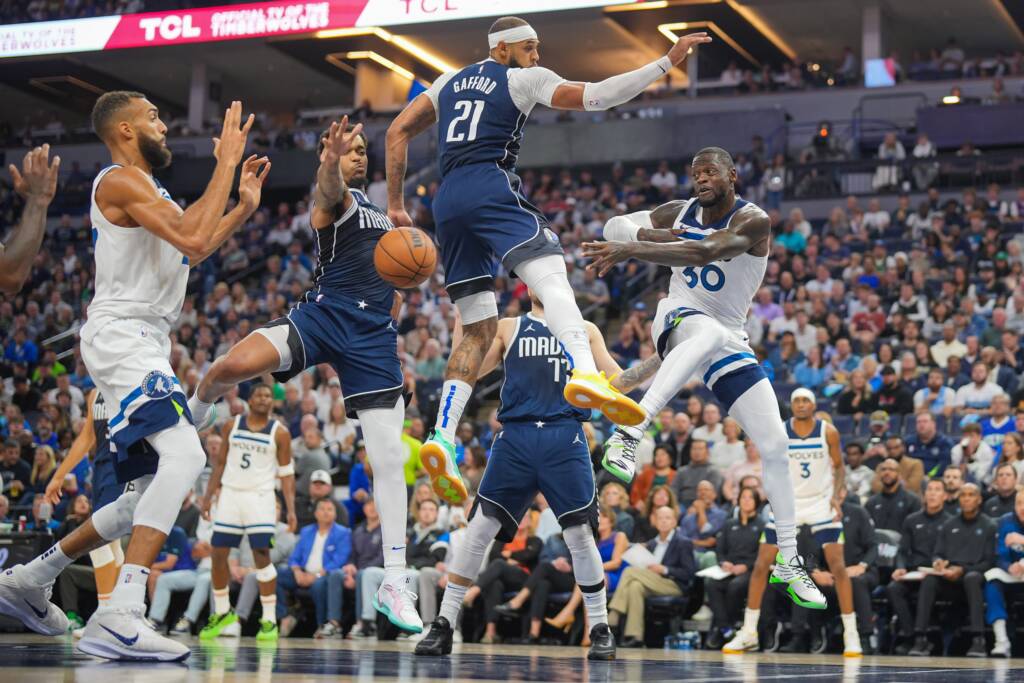The national media heavily scrutinized the Minnesota Timberwolves when they traded most of their draft capital for Rudy Gobert two years ago. Some of the negativity arose from the price paid for Gobert. But much of the dialogue surrounded Minnesota’s spacing and fit of two 7-footers in Gobert and Karl-Anthony Towns within the front court.
The Timberwolves have an up-and-coming star in Anthony Edwards and plugged two giants alongside him. Serious questions would arise about how these two bigs could affect Edwards’s development.
Towns had already proven himself an elite three-point shooter and floor spacer, mixing size and shot efficiency. However, Gobert is incredibly limited offensively, living in the restricted area on a heavy diet of dunks and layups. Tim Connelly and the front office gambled on talent over proper fit and decided to work through the kinks as the season progressed.
Results varied in Year 1 of the duo, but the Wolves persisted. They found schematic advantages and built through continuity. They structured a lot of their offense through their screen usage. The Timberwolves also featured Horns sets and 4/5 pick-and-roll with the two bigs, keeping both engaged within the offense.
The Wolves became the league’s best defense, but their ability to be an effective offense proved their ceiling. Launching them to their best season and first conference finals run in two decades.
Just as the Wolves got comfortable, they shook it all up again. Weeks before training camp, they traded Towns to the New York Knicks for Julius Randle and Donte DiVincenzo.
DiVincenzo was fresh off a historic 3-point shooting season, setting the Knicks franchise record with 283 three-point makes. He fit in seamlessly. However, the Randle/Gobert fit began to raise even more questions about the frontcourt spacing.
Randle didn’t become a 3-point shooter until his fifth year in the league and was a career 33.3% 3-point shooter entering this season. Therefore, people had valid concerns about pairing him with Gobert. However, as we saw with the Towns-Gobert pairing, there is more to spacing than true 3-point shooting ability.
The idealistic concept of flow, which Chris Finch repeats feverishly, is rooted in Minnesota’s offense. Within the idea of flow in the half-court, players properly know where to position themselves away from the ball, a trait that takes time to develop and requires a high basketball IQ. Finding the balance between players knowing where to be on the court and their next move will keep the defense guessing.
The perfect storm of offense is the mix of this flow and varying lineup versatility. That allows the Wolves to be creative within the offense while using their players’ varying skill sets to remain dynamic. However, that’s easier said than done.
Fortunately for Finch and the new Randle/Gobert frontcourt, there are plenty of ways to mimic spacing. It’s not tied directly to true 3-point shooting ability. Randle already showcased spacing in New York, often operating next to two other “traditional” bigs in Mitchell Robinson and Isaiah Hartenstein.
Coaches can offer valuable instruction. Still, players must fully embrace their skill set and make things work.
Draymond Green famously embraced players sagging off him by becoming a screen/hand-off hub for Stephen Curry during the Golden State Warriors dynasty. Green allowed the Warriors to gain a 2-on-1 advantage with the sagging defender entirely out of the play, generating plenty of open looks for their generational shooting talents.
Randle does not need to completely change the game like Draymond did. Still, it’s important to note that just because Randle and Gobert aren’t going to help the Wolves stretch defenses the way the Boston Celtics or Oklahoma City Thunder do doesn’t mean they cannot find success offensively elsewhere.
The new Randle-Gobert frontcourt duo has not developed the direct chemistry that Towns-Gobert achieved. Still, their offensive flow has immediately been more fluid. The Wolves still feature PnRs involving both players, and Randle has begun to look Gobert’s way as a dump-off outlet off of his rim attacks.
Seeing Randle and Gobert gel enough on the floor offensively gives the Wolves built-in optionality. Most of their connections have come from secondary actions or end-of-clock situations. Therefore, once their strengths and weaknesses are known together, it can ideally become more optimized, giving the balance of structure and freelance within what is already working.
It is still early in the season, so take much of the results with a grain of salt. The Randle-Gobert frontcourt duo has already shown many of the same abilities as the Towns-Gobert frontcourt but with even more upside to build toward.

